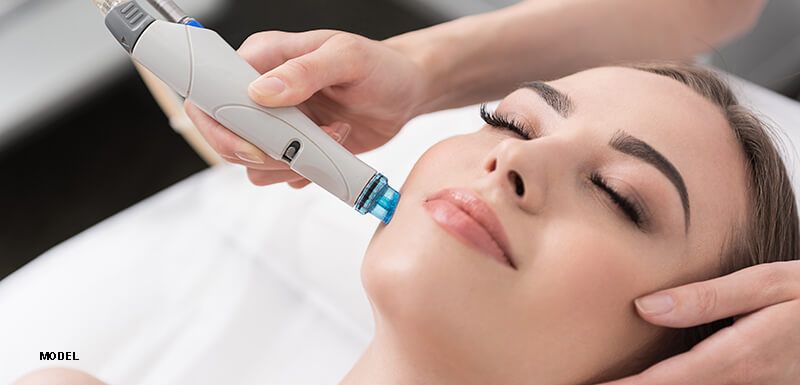Treating Rosacea with Laser & Light Therapy

Rosacea is a common inflammatory skin condition that causes a blushed, reddish patches along the skin. This chronic skin condition can also manifest as bumps, similar to acne, and can lead to thickened skin. While rosacea is not thought of as harmful, moderate to severe rosacea can have a negative effect on appearance, leading sufferers to feel embarrassed or self- conscious.
Unfortunately, there is no cure for rosacea. Symptoms can, however, be managed by avoiding triggers that result in flare-ups. There are also numerous treatment options including oral medications, topical treatments, and professional (in-office) treatments like Botox. Laser and light therapy are two highly effective rosacea treatment options, especially when part of a holistic rosacea skincare plan administered by a professional.
What is Rosacea?
Rosacea is actually an umbrella term for a number of inflammatory skin conditions. These conditions are chronic, although they may cycle through periods of flare-ups and relative calmness.
- Erythematotelangiectatic Rosacea (ETR)
ETR is the most common form of rosacea. It presents as generally flushed or blushed skin.
- Papulopustular Rosacea (Acne Rosacea)
With acne rosacea, inflammation leads to bumps and breakouts, similar to acne. In addition, some areas of the skin may thicken into plaques.
- Phymatous Rosacea (Rhinophyma)
Phymatous rosacea includes symptoms of ETR as well as skin thickening. In particular, skin thickens around the nose, which may cause it to appear bulbous or misshapen.
- Ocular Rosacea
Ocular rosacea impacts the skin around the eyes. In addition to red skin, the eyes may become watery, irritated or light sensitive.
What To Know About Laser & Light Treatments for Rosacea
Treatment plans for rosacea are likely to include laser and light therapy if the rosacea has led to enlarged, visible blood vessels or thickening of the skin.
Decreasing Redness: Some lasers work by targeting visible blood vessels with heat. This collapses the blood vessels, reducing redness. While collapsed blood vessels will not return, other blood vessels may later become visible.
Addressing Thick Skin: Laser resurfacing treatments can address plaques and thick skin on and around the nose.
Laser and light therapy are non-invasive and relatively painless treatment options. Laser or light therapy is typically recommended for patients when other treatment options like topical treatments or medications are unable to significantly reduce the rosacea symptoms.
Types of Lasers and Light Therapy for Rosacea
There’s no single type of laser and light therapy that works the best for rosacea. The type that works best for you will depend upon your unique skin condition, and the issues you’d like to address. A dermatologist can help you create the most appropriate treatment plan. Types of treatment include the following:
Pulsed Dye Lasers
Pulsed dye lasers treat inflammation, redness and visible blood vessels. These lasers emit a light which is absorbed by red blood cells only, protecting the surrounding skin. Blood vessels collapse as their lining is destroyed, reducing skin’s redness.
CO2 Lasers and Erbium YAG lasers
CO2 and YAG lasers are skin resurfacing lasers which treat skin thickening, scarring or bumps caused by rosacea. These lasers can also help reshape bulbous noses by exfoliating skin’s outer layer and stimulating new skin growth.
Intense Pulsed Light Therapy (IPL)
Technically, IPL is not a true laser treatment. This therapy uses light waves of different lengths to target skin’s redness. The light damages blood vessels, resulting in fewer visible capillaries and less pigmentation.
Are Multiple Treatments Necessary?
While you may see improvement after a single session, multiple treatments are necessary to achieve the best possible results.
How many treatments you need depends on the severity of your rosacea, your unique skin condition, and how well your skin responds to laser therapy.
Most patients need between 2-8 sessions, which are spaced anywhere from 2-6 weeks apart.
What Results Can Patients Expect?
Pulsed-dye lasers and IPL therapy work best to reduce inflammation and redness. Using these methods, most patients report a significant reduction in redness after 1-3 treatments.
CO2 and erbium YAG lasers work best to treat bumps, scarring and thickened skin. Patients who treat their thickened skin earliest tend to see the best results.
In addition to decreased redness and thick skin, laser therapy can improve skin’s overall smoothness. It stimulates collagen production for fewer fine lines and wrinkles.
The results of laser therapy may last for up to 5 years, but they are not permanent. Follow-up appointments are generally needed for longer lasting results.
What Are the Risks?
Both laser and light therapy require little to no recovery time. Immediately after treatment, you may experience redness and swelling, a sensation of tightness or itching, or mild bruising. These mild side effects should resolve on their own within 1-2 weeks.
If you experience additional side effects, or if your skin feels as though it might be burning, contact your doctor immediately.
Risks are minimized by seeing an experienced, board-certified dermatologist for treatment. A dermatologist understands the skin and is familiar with rosacea in all its forms. By reviewing your medical history and the condition of your skin, your dermatologist can recommend a comprehensive skincare plan. This plan will only include laser and light therapy if they feel it will be effective.
Disclaimer: The contents of the Westlake Dermatology website, including text, graphics, and images, are for informational purposes only and are not intended to substitute for direct medical advice from your physician or other qualified professional.
